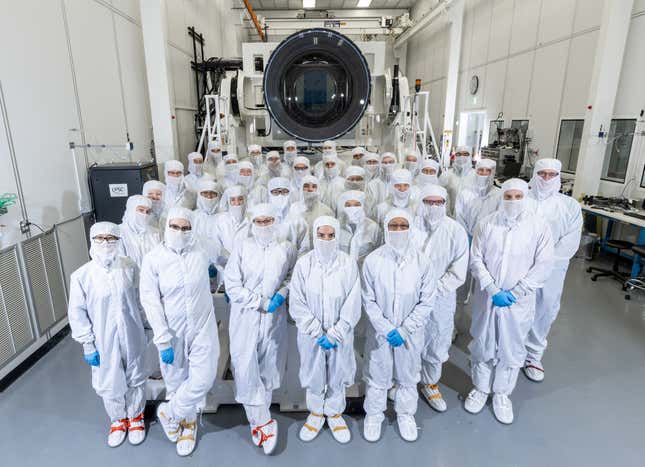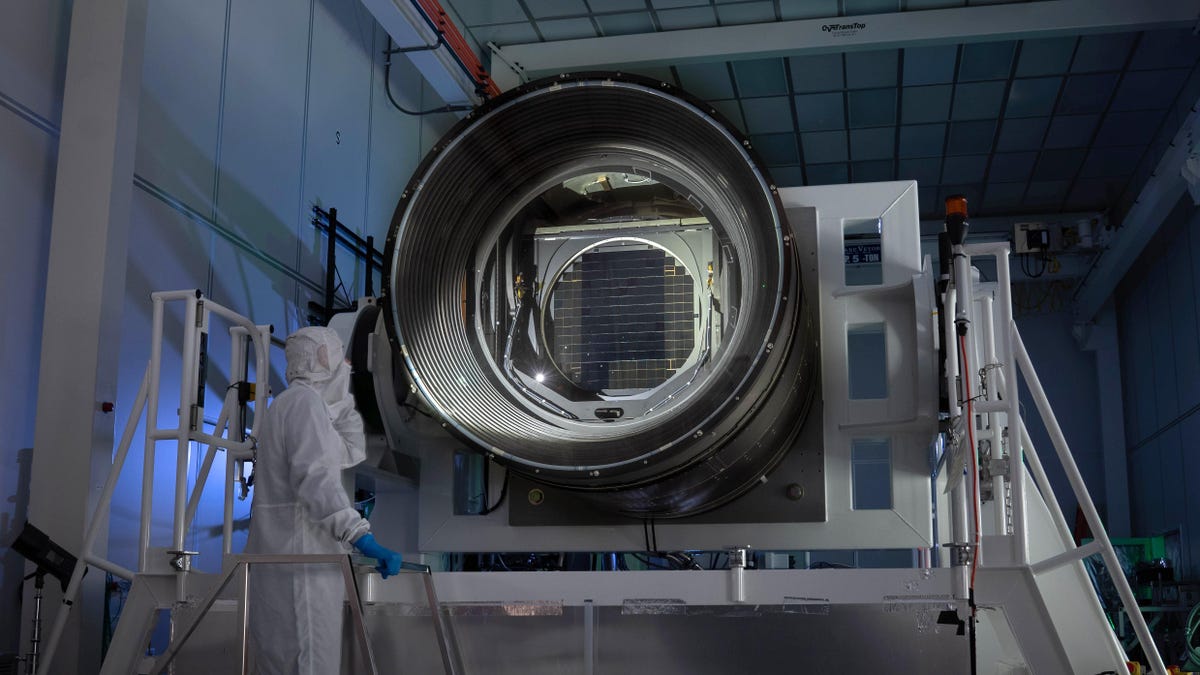Nine years and 3.2 billion pixels later, it is complete: the LSST Camera stands as the largest digital camera ever built for astronomy and will serve as the centerpiece of the Vera Rubin Observatory, poised to begin its exploration of the southern skies.
The Rubin Observatory’s key goal is the 10-year Legacy Survey of Space and Time (LSST), a sweeping, near-constant observation of space. This endeavor will yield 60 petabytes of data on the composition of the universe, the nature and distribution of dark matter, dark energy and the expansion of the universe, the formation of our galaxy, our intimate little solar system, and more.
The camera will use its 5.1-foot-wide optical lens to take a 15-second exposure of the sky every 20 seconds, automatically changing filters to view light in every wavelength from near-ultraviolet to the near-infrared. Its constant monitoring of the skies will eventually amount to a timelapse of the heavens; it will highlight fleeting events for other scientists to train their telescopes on, and monitor changes in the southern sky.
“We will soon start producing the greatest movie of all time and the most informative map of the night sky ever assembled,” said Željko Ivezić, an astrophysicist at the University of Washington and director of the Rubin Observatory’s construction, in a SLAC release.
To do this, the team needed a Rolls Royce of a digital camera. Mind you, the camera actually cost many million times that of an actual Royce Royce, and at 6,200 pounds (2,812 kilograms), it weighs a lot more than a fancy car. Each of the 21 rafts that makes up the camera’s focal plane is the price of a Maserati, and are worth every penny if they collect the sort of data scientists expect them to. Gizmodo visited the camera in its clean room in 2021—you can read all about it here.
“I’m personally most excited to study the expansion of the Universe using gravitational lenses to better understand Dark Energy,” said Aaron Roodman, a physicist at SLAC and lead on the camera program, in an email to Gizmodo. “That means two things: 1) measuring the brightness in all six of our filters of literally billions of galaxies and very carefully measuring their shape, which has been subtly altered by the bending of light by matter, and 2) discovering and studying very special objects where a distant quasar is almost perfectly lined up with a more nearby galaxy.”
Speaking through a SLAC release, Roodman said the camera’s images could “resolve a golf ball from around 15 miles away, while covering a swath of the sky seven times wider than the full moon.” Think about that the next time you try (and fail) to take a decent picture of the Moon with your phone camera.
Though it’s getting harder to see the stars due to human skyglow, the Rubin Observatory is high in Chile’s Atacama Desert, a famously popular region for telescopes. Unfortunately, even being in such a dry, high, cloudless place doesn’t free telescopes from light pollution off Earth: satellites. As satellites pass overhead, their lights leave long streaks in telescope images; groups of satellites working together, known as constellations, pose a more vexing problem.
“The current constellations will be a significant nuisance but we one we can deal with by cutting out the streaks on the image that these satellites will produce,” Roodman said. “However, if the number and brightness of these satellites increases then it will have a bigger and more negative impact on our 10-year survey.”
A 2022 review of the issue suggested that SpaceX’s entire constellation of 42,000 satellites would pop up in 30% of the LSST camera’s images—and that’s not to mention other satellites operating in low Earth orbit. There are workarounds for the irksome streaks; last year, a team of researchers at the Space Telescope Science Institute announced a way of “cleaning” the satellites from Hubble Space Telescope images. However, space-borne messes are just like the ones in your kitchen: better to not have them in the first place.

The first images from the Rubin Observatory are slated to be publicly released in March 2025, which feels like a long way away. But several important agenda items still need to happen. For one, the SLAC team has to ship the LSST camera safely to Chile from its current lodgings in northern California. (Don’t worry—they’ve made a test run of the journey.) Then, the observatory’s mirrors need to be readied for testing and the observatory’s dome has to be completed, among some other tasks. But whenever all that is complete, the legacy survey will launch into a decade’s worth of scientific discovery.
Rubin Observatory estimates suggest that LSST could “increase the number of known objects by a factor of 10,” according to a SLAC release. Basically, having such a constant eye on a large swathe of the sky will reveal how dynamic our universe truly is, both in our cosmic neighborhood and the star-spangled yonder.
More: Engineers Heat Up Dark Universe Telescope, Restoring Euclid’s Sight

Daisy Hips is a science communicator who brings the wonders of the natural world to readers. Her articles explore breakthroughs in various scientific disciplines, from space exploration to environmental conservation. Daisy is also an advocate for science education and enjoys stargazing in her spare time.






/cdn.vox-cdn.com/uploads/chorus_asset/file/23318433/akrales_220309_4977_0182.jpg)